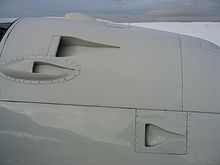NACA duct

A NACA duct,
Design
Prior submerged inlet experiments showed poor
Aircraft applications

When properly implemented, a NACA duct allows air to flow into an internal duct, often for cooling purposes, with a minimal disturbance to the flow. The design was originally called a submerged inlet, since it consists of a shallow ramp with curved walls recessed into the exposed surface of a streamlined body, such as an aircraft.
This type of flush inlet generally cannot achieve the greater ram pressures and flow volumes of an external design, and so is rarely used for the jet engine intake application for which it was originally designed, such as the North American YF-93 and Short SB.4 Sherpa. It is commonly used for piston engine and ventilation intakes.
Automobile applications

It is especially favored in
See also
References
- ^ Frick, Charles W., et al. NACA ACR No. 5120, An Experimental Investigation of NACA Submerged- Duct Entrances. NACA, November 13, 1945. Abstract, Full report.
- ^ "NACA UK Mirror report description page".
- ^ "MAGiC NACA Archive".
- ^ "Duct Soup – How A NACA Duct Works". Hot Rod. 18 July 2013.
- ISBN 1-85960-846-9. (Practical guidance on designing and building NACA ducts for motor-racing applications)
Further reading
- Frick, Charles W.; Davis, Wallace F.; Randall, Lauros M.; Mossman, Emmet A. (October 1945). "An Experimental Investigation of NACA Submerged-Duct Entrances". NASA Scientific and Technical Information Program. Retrieved 2017-03-26.
NACA-ACR-5I20
- Warren Beauchamp (2000). "NACA Duct Rationale and Construction".
Practical experience of fabricating simple NACA ducts for ventilation of a HPV
